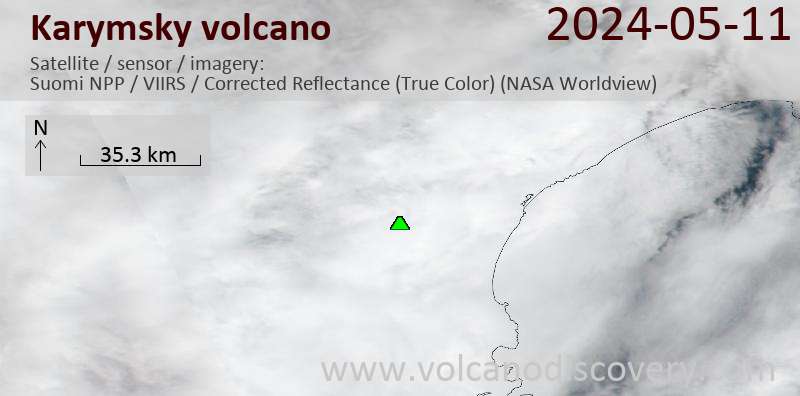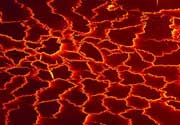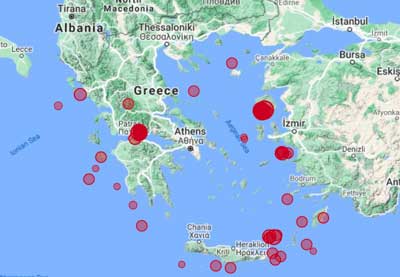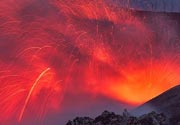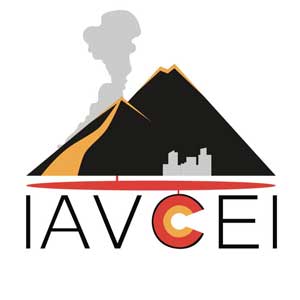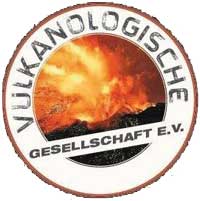Karymsky Volcano
Karymsky is the most active volcano of Kamchatka's eastern volcanic zone and a perfect symmetrical stratovolcano. Ash eruptions from Karymski can come in the way of aircraft flight routes across the N Pacific. Karymsky, the most active volcano of Kamchatka's eastern volcanic zone in one of the world's volcanoes with persistent activity and has been erupting for at least about 500 years.
Karymsky volcano eruptions: 1771, 1830, 1852, 1854, 1908, 1911, 1912, 1915, 1921, 1923, 1925, 1929, 1932, 1933, 1934, 1938, 1940, 1943, 1945, 1946, 1947, 1952, 1953, 1955, 1956, 1960, 1965, 1967, 1970, 1982, 1983, 1985, 1990, 1993, 1996 - ongoing
Latest nearby earthquakes
| Date and Time | Mag / Depth | Distance / Location | |||
|---|---|---|---|---|---|
Background
Much of the cone is surrounded by lava flows no older than 200 years. Historical eruptions have been vulcanian or vulcanian-strombolian with moderate explosive activity and occasional lava flows from the summit crater.The cone has been constructed during the past 2000 years within a 5-km-wide caldera that formed about 9,000 year ago within a complex system of overlapping calderas. The caldera cuts the south side of the older Dvor volcano and is located outside the north margin of a large, still older caldera (the mid-Pleistocene Polovinka caldera), which contains the smaller Akademia Nauk and Odnoboky calderas.
Most seismicity preceding Karymsky eruptions originated beneath Akademia Nauk caldera, which is located immediately south of Karymsky volcano.
---
Source: GVP, Smithsonian Institution
Karymsky Volcano Photos
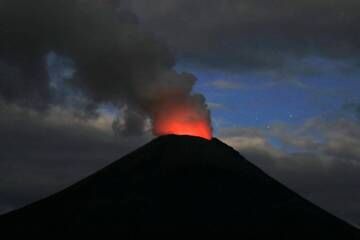
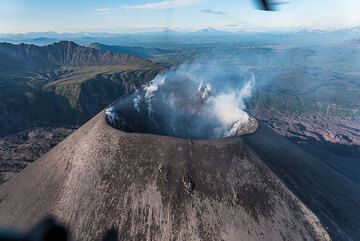
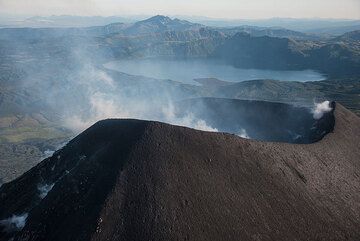
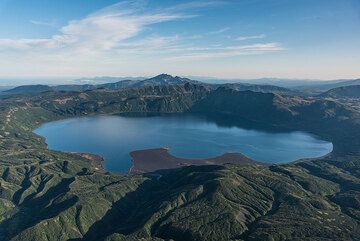
Significant volcanic eruptions: Karymsky volcano
There is one uncertain or discredited eruption in 1985 from Karymsky volcano.
| Date | Note | VEI | Deaths | Damage | ||
|---|---|---|---|---|---|---|
Historical obs./docs. | ? | |||||
Historical obs./docs. | 3 | |||||
Historical obs./docs. | 2 | |||||
| Summit crater Historical obs./docs. | 3 | |||||
Historical obs./docs. | 3 | |||||
| Summit crater Historical obs./docs. | 2 | |||||
| Summit and upper south flank Historical obs./docs. | 3 | |||||
| New summit crater SW of 1970-82 crater Historical obs./docs. | 3 | |||||
| 1996 Jan 2 (eruption | Tsunami recorded Historical obs./docs. | 2 | ||||
Discredited Eruption | ||||||
Historical obs./docs. | 3 | |||||
Historical obs./docs. | 1 | |||||
Historical obs./docs. | 3 | |||||
Historical obs./docs. | 3 | |||||
Historical obs./docs. | 1 | |||||
Historical obs./docs. | 2 | |||||
Historical obs./docs. | 2 | |||||
Historical obs./docs. | 2 | |||||
Historical obs./docs. | 2 | |||||
Historical obs./docs. | 2 | |||||
Historical obs./docs. | 2 | |||||
Historical obs./docs. | 2 | |||||
Historical obs./docs. | 2 | |||||
Historical obs./docs. | 2 | |||||
Historical obs./docs. | 2 | |||||
Historical obs./docs. | 2 | |||||
Historical obs./docs. | 2 | |||||
Historical obs./docs. | 2 | |||||
Historical obs./docs. | 2 | |||||
Historical obs./docs. | 2 | |||||
Historical obs./docs. | 2 | |||||
Historical obs./docs. | 2 | |||||
Historical obs./docs. | 2 | |||||
Historical obs./docs. | 2 | |||||
Historical obs./docs. | 2 | |||||
Historical obs./docs. | 2 | |||||
Karymsky Volcano FAQ
+When was the last eruption of Karymsky volcano?
The last confirmed eruption of Karymsky occurred in 2024.
+How often does Karymsky volcano erupt?
Since 1771, Karymsky volcano has had at least 38 historically documented eruptions. This means that it erupts on average every 6.7 years.
Many eruptions of Karymsky have lasted more than one year. In total, the volcano has been in eruption during 76 out of 254 years until now. In other words, Karymsky has been active at least one in 3.3 years on average. Note that this value is likely an underestimate, because the known history of eruptions from Karymsky is likely incomplete, especially further back in time.
+How active is Karymsky volcano at present?
Karymsky volcano is extremely active: Since 1900, it has been frequently active, showing eruptive activity during 72 years out of 126 as of now. The last eruption was in 2024 and ended 7 months ago.
+When was the largest eruption of Karymsky volcano?
The largest eruption known from the younger geological history of Karymsky volcano occurred in 6600 BC. It ranks as a "vulcanian" eruption with a magnitude 3 on the VEI (Volcanic Explosivity Index) scale.
Latest satellite images
Price 0 €
Karymsky Volcano Maps


























